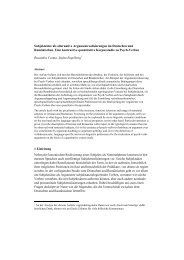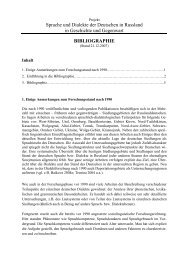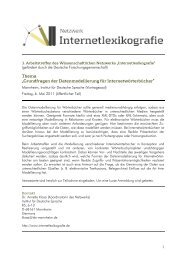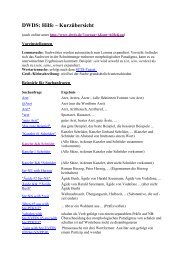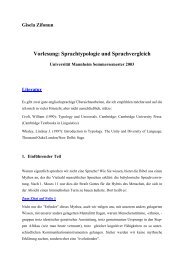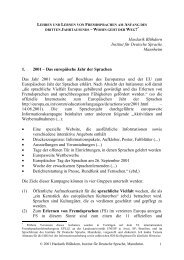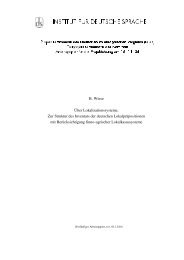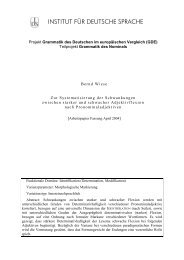Subordination and coordination in syntax, semantics and discourse ...
Subordination and coordination in syntax, semantics and discourse ...
Subordination and coordination in syntax, semantics and discourse ...
Create successful ePaper yourself
Turn your PDF publications into a flip-book with our unique Google optimized e-Paper software.
Hardarik BlühdornThe second <strong>and</strong> fourth tests seem to be somewhat circular, s<strong>in</strong>ce what can be“<strong>in</strong>ferred” from them is little more than a reformulation of their <strong>in</strong>put conditions.The first test is more <strong>in</strong>terest<strong>in</strong>g, but the authors warn that it might not beconclusive <strong>in</strong> all cases.When apply<strong>in</strong>g the tests to some concrete examples, Asher & Vieu recognizethat there are more difficulties. An analysis of the <strong>discourse</strong> relation Result(ibid.: 604ff) suggests that it can be “used” either <strong>in</strong> a coord<strong>in</strong>at<strong>in</strong>g or <strong>in</strong> asubord<strong>in</strong>at<strong>in</strong>g manner. The same possibility might exist for other <strong>discourse</strong>relations as well. Asher & Vieu do not expla<strong>in</strong> what exactly it means for a<strong>discourse</strong> relation to be “used”. But they draw the conclusion that “the conceptsof subord<strong>in</strong>at<strong>in</strong>g <strong>and</strong> coord<strong>in</strong>at<strong>in</strong>g <strong>discourse</strong> relations” might be founded neitheron <strong>semantics</strong> nor on <strong>syntax</strong>. Instead they suggest that these properties might be amatter of <strong>in</strong>formation packag<strong>in</strong>g (ibid.: 600, 609).4.3 Future perspectivesAn important conclusion to be drawn from the discussion of different models of<strong>discourse</strong> structure is that <strong>discourse</strong> should be viewed as a system sui generis.Discourse structure is the arrangement of <strong>discourse</strong> units (see Polanyi 1988:603ff), which can be ordered on different levels of constituency as well as ondifferent levels of focality. On higher levels of constituency, the units arestructurally more complex, on lower levels they are structurally more simple. Onhigher levels of focality, units are more central to the communicative goals ofthe speaker, on lower levels of focality, units have support<strong>in</strong>g or secondaryfunctions (see Kle<strong>in</strong> & von Stutterheim 1992). Non-hierarchical <strong>discourse</strong>relations connect units of the same level, either of constituency or of focality(<strong>in</strong>tra-level connection); hierarchical <strong>discourse</strong> relations connect units ofdifferent levels of constituency or of focality (<strong>in</strong>ter-level connection).Discourse should not be viewed from the beg<strong>in</strong>n<strong>in</strong>g as someth<strong>in</strong>g derived from<strong>syntax</strong> <strong>and</strong>/or <strong>semantics</strong>. Hybrid conceptualizations make it more difficult torecognize genu<strong>in</strong>e <strong>discourse</strong> properties <strong>and</strong> makes <strong>discourse</strong> studies moresusceptible to precipitate conclusions. The <strong>in</strong>teraction between hierarchical <strong>and</strong>non-hierarchical connections <strong>in</strong> <strong>syntax</strong>, <strong>semantics</strong> <strong>and</strong> <strong>discourse</strong> can only bedescribed <strong>in</strong> appropriate detail on the basis of <strong>in</strong>dependent <strong>and</strong> explicit theoriesof each of the three doma<strong>in</strong>s of language structure.Recent research <strong>in</strong> the areas of <strong>in</strong>tonational phonology <strong>and</strong> conversationalanalysis (see e.g. Chafe 1988; Selt<strong>in</strong>g 1995; Peters 2005; Bür<strong>in</strong>g 2006; Moroni2006) has shown ever more clearly that a considerable part of <strong>discourse</strong>26© 2007 Hardarik Blühdorn, Institut für Deutsche Sprache, Mannheim.


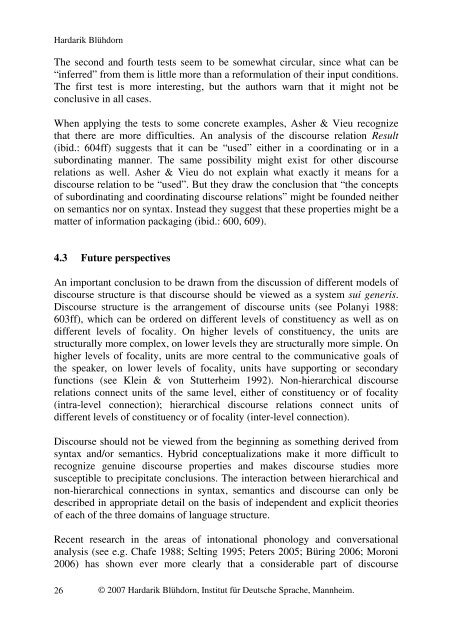
![Ãœbersetzungen-19[1]. - Institut für Deutsche Sprache](https://img.yumpu.com/51701205/1/184x260/aoebersetzungen-191-institut-fur-deutsche-sprache.jpg?quality=85)


